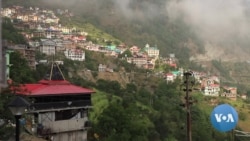In the remote Himalayan hamlet of Bharmour in the northern Himachal Pradesh state there was no orthopedic to examine Ajay Singh’s persistent backache. When the pain continued for weeks, the local medical center arranged an online consultation with a specialist in the southern city of Chennai over 2000 kilometers away — he prescribed a line of treatment that local staff monitors.
Like him, scores of others have accessed highly qualified doctors in India’s big hospitals through a telemedicine program launched last November.
Sanjay Sharma, 42, says the constant irritation in his throat has improved since taking medication prescribed after a virtual consultation with a specialist. It saved him a long and expensive journey 400 kilometers away to the state capital, Shimla — the nearest city that boasts of well-equipped hospitals and doctors.
“I would have had to travel at least 10 to 15 hours to consult a doctor. I have saved both time and money,” says a relieved Sharma.
The telemedicine program in Bharmour using modern communication technology is helping bridge the huge divide between India’s urban and rural healthcare. While big cities boast of highly qualified doctors and super specialty hospitals, India’s vast countryside struggles with grossly inadequate health infrastructure. Expenses incurred in travelling and staying in distant cities often impoverished villagers.
This shortage of qualified medical personnel is even more pronounced in villages like Bharmour where the tiny population, distant location and bad weather make it even harder to attract staff.
“Most of the time these were cut off from the rest of the world due to heavy snowfall and passes getting blocked,” points out Rajesh Guleri, the chief medical officer in Chamba district, where Bharmour is located. “People had no option but to get whatever treatment is available because airlifting them is very difficult.”
India has one doctor for about 1500 people — lower than the World Health Organizations’ recommendations of one for 1000. That ratio plummets much lower in rural areas because most of the doctors prefer to practice in the country’s densely packed cities.
Bharmour is the second place in Chamba district to get access to telemedicine — it was first introduced in another remote settlement, Pangi in 2018. Satellite technology helps overcome the poor connectivity in these areas.
“We have consultations in about 26 specialties and super specialties such as dermatologists, cardiologists and neurologists which for a state of Himachal Pradesh is not easy,” says Guleri. “Although we cannot do any surgical intervention, but emergencies can be handled with telemedicine by stabilizing patients who may need surgery.”
India is turning attention on how telemedicine can help overcome the grossly inadequate health infrastructure in rural areas – especially after the COVID 19 pandemic turned the spotlight on virtual and online consultations. However public health experts point out that while technology can show the way ahead, it must be done with adequate checks and balances.
“It can work in areas with an efficient primary health care system which can be the interface between the patient and the specialist health care provider,” says Srinath Reddy, President of the Public Health Foundation of India in New Delhi. “It is a very important technological advance. But you need to strengthen the primary health care system because a lot of the care has to be delivered as close to home as possible and ultimately its success will depend on how the treatment is handled by the medical staff on the ground.”
While vast parts of rural India lack such a primary health care system, Himachal Pradesh bucks that trend. The state’s spending on healthcare is the highest in the country and it has been credited with building a good network of local health centers in its mostly remote hilly regions.
In Bharmour, staff has now been trained to conduct tests such as ultrasounds and electrocardiograms — specialists in a private healthcare provider with which the state government has partnered, access the reports online.
About 3000 consultations and 60 emergencies have also been handled in both areas so far, according to authorities.
For Anil Kumar’s brother living in Bharmour, a cardiologist’s diagnosis was timely – he needed quick attention and arranged to travel to a hospital in Shimla.
“The doctors told us he has a heart problem, a blockage…. We went to Shimla city where doctors put a stent. That solved the problem,” according to Kumar.
The telemedicine program is also helping women whose health problems in rural areas often get neglected.
“I had severe headaches. Doctors diagnosed it as migraine and also weak eyesight,” says Reeta Devi. The medicines I am having since a month are helping.”
While telemedicine could take time to make an impact in much of rural India, in this Himalayan hamlet fears that the long winding roads to the nearest city will cut them off from medical care have been eased.








